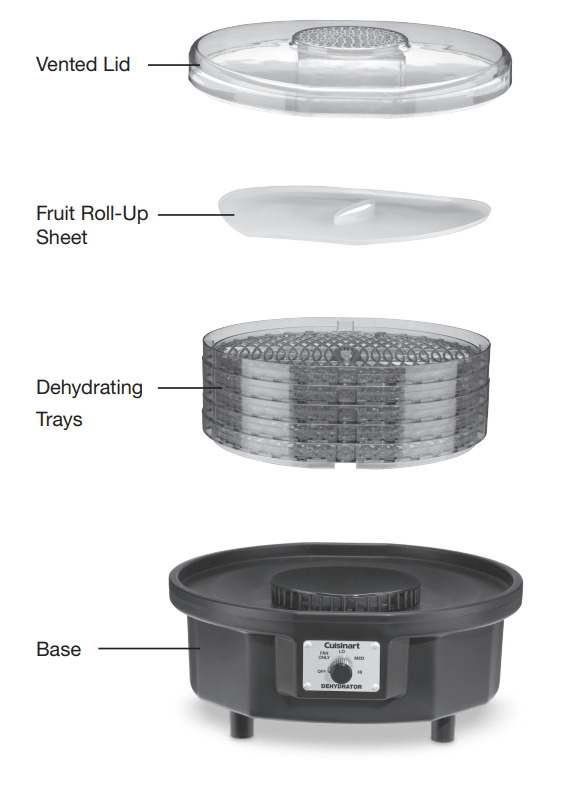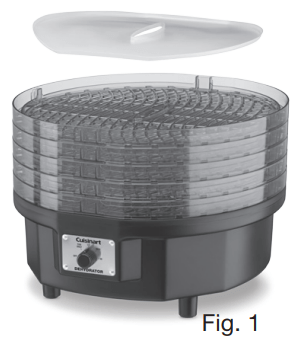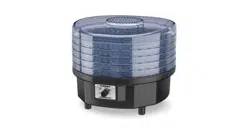Documents: Go to download!
- Owner's manual - (English, Spanish)
- INTRODUCTION
- OPERATING INSTRUCTIONS
- BEFORE USING
- USAGE
- PARTS AND FEATURES
- HOW TO USE THE FRUIT ROLL-UP SHEET
- CLEANING AND MAINTENANCE
- FOOD SELECTION
- VEGETABLE PREPARATION AND TREATMENT
- PREPARATION
- PRETREATMENT
- STEAM BLANCHING
- MICROWAVE BLANCHING
- Fruit and Nuts Preparation and Treatment
- USEFUL TIPS
- FOOD STORAGE
- RECIPES
Table of contents
INSTRUCTION AND RECIPE BOOKLET Dehydrator
INTRODUCTION
- The dehydration of fruits and vegetables is one of the earliest methods of food preservation. Since their discovery and cultivation, plums and grapes have been sun-dried into prunes and raisins. These dried fruits and vegetables make great snacks or desserts, and it’s easy to dehydrate different meats to make jerky. Dehydration is a healthy way of preserving food because bacteria growth is inhibited by the removal of moisture. You can even use your food dehydrator to dry flowers and make potpourri! Before using your food dehydrator, be sure to take time to read the “Important Safeguards” and all other instructions in this manual.
OPERATING INSTRUCTIONS
- This appliance is meant for household use only. First, place it on a level surface, and then insert the plug into a 120V rated electrical outlet. Do not use any other rated type outlet. This food dehydrator has a polarized plug (one blade is wider than the other). To reduce risk of electric shock, this plug is intended to fit into a polarized outlet only one way. If the plug does not fit fully into the outlet, reverse the plug and try again. If it still does not fit, contact a qualified electrician. Do not attempt to modify the plug in any way. Attempting to defeat this safety feature may result in damage to the plug or the outlet.
- The food dehydrator is equipped with a short power-supply cord, reducing the risk of tangling or tripping over a longer cord. Extension cords can be used with the proper attention paid to safety concerns. When using a longer, detachable power-supply cord or extension cord, the marked electrical rating of the extension cord should be the same or greater as the electrical rating of the appliance, and the longer cord should not drape over the counter top or table where children could pull it or it could be tripped over unintentionally.
BEFORE USING
- Unpack the food dehydrator with care.
- Wash all of the dehydrator trays and lid in warm, soapy water. Rinse well and dry completely.
- Wipe the dehydrator base with a clean and dry, soft cloth or sponge. Never immerse base, plug or cord in water or any other liquids.
USAGE
- First, ensure the unit is turned to the OFF position and unplugged before preparing to use.
- Wash the trays and lid before each use to prevent food contamination.
- Place the base on a flat, smooth counter top surface.
- Prepare food to be dehydrated as instructed, depending on the type of food; never overlap food or overload trays.
- Arrange food on trays, stack up the trays, and set them aside.
- Trays can accommodate a variety of food sizes with small adjustments.
- Plug unit into electrical wall outlet. Set control knob to desired setting.
- Place stacked trays on base and cover the top tray with the lid. Then allow the food to dry for the recommended length of time (drying time depends on the food type).
- Top lid vent holes must be kept clear of any objects.
- Monitor the food while it is dehydrating and check it for desired doneness. It may be necessary to rotate the racks during drying as bottom racks will dehydrate faster than top racks. Once cooled, remove individual pieces and store in food-safe containers or plastic bags, preferably airtight. Leave the pieces that are not yet done in the dehydrator and monitor them until done.
- Store the pieces that are not going to be eaten in the next few days in the freezer. When storing food in the freezer, use containers or bags designed specifically for freezer storage.
- Switch the unit to OFF and unplug after using.
- Wash the dehydrator trays and lid after each use. Wipe the base with a soft, slightly damp cloth or sponge; never let water or any other liquid get into the base. Be sure the trays and lid are completely dry before storing them back on the base.
CAUTION:
- Do not block cover vents.
- Do not block bottom vents.
PARTS AND FEATURES

HOW TO USE THE FRUIT ROLL-UP SHEET
- Your unit comes with one fruit roll-up sheet.
- To prepare fruit roll-up sheet, lightly spray a paper towel with cooking spray and rub over the fruit roll-up sheet. Follow preheating preparation instructions which can be found in the recipe section of the instruction book for Yogurt Roll-Ups, Spiced Apple Trail Mix Leather and Strawberry Banana Leather. Once your fruit roll-up sheet is ready, place on top rack of unit as shown in Fig. 1.

CLEANING AND MAINTENANCE
- Dehydrator racks, top cover and fruit roll-up sheet are all dishwasher safe.
- To clean unit base, unplug from outlet and wipe clean using a damp cloth. Wipe dry with a clean cloth.
- NOTE: Any other servicing should be performed by an authorized service representative.
FOOD SELECTION
- Select foods for dehydration that are in good condition. Fruits should have just become ripe since they contain the highest amount of natural sugar and provide the best results. Vegetables should be fresh and crisp. Avoid fruits that are not ripe; they yield unpredictable results and often have a flat, bitter taste. Overripe fruits and vegetables with spoiled portions should also be avoided. Cut off any bruised or marred portions of the fruits and vegetables before dehydration. Meat, poultry and fish should be fresh and lean. Preparation, dehydration time and foodstorage method will also influence their quality and taste. Follow preparation, dehydration and storage instructions in this manual to ensure the best-tasting, highest quality dried foods.
- IMPORTANT: If you suspect food contamination, do not attempt to use the dehydrator. Discard the food.
VEGETABLE PREPARATION AND TREATMENT
- Vegetables are low in acid and have less sugar than fruits, so they require a little more effort. Some vegetables are better frozen than dried, so remember to be selective in the vegetables you choose.
PREPARATION
- Only the highest quality vegetables should be selected for drying. Wash them carefully just before dehydrating to remove dirt and bacteria. Most vegetables should be peeled, trimmed, cut or shredded prior to drying.
PRETREATMENT
- Blanching vegetables prior to drying is recommended. This destroys the enzymes that can produce “off” flavors when stored and lead to poor texture and poor rehydration. Steam blanching is a better method than water blanching because more flavor and vitamins are retained. Vegetables can also be microwaved.
STEAM BLANCHING
- Layer prepared vegetables in the top portion of a steamer or a steamer insert and steam until the vegetables are heated through, but are not cooked enough to eat (usually 2 to 3 minutes). Stir to ensure all vegetables are evenly blanched. Quickly transfer steamed vegetables directly to drying trays.
MICROWAVE BLANCHING
- Microwave ovens can easily be used to blanch fresh vegetables. Prepare vegetables the same way as for steam blanching. Place vegetables in a covered casserole dish with a small amount of water (refer to your microwave oven cooking chart). Cook for ¼ to 1 ⁄3 the time listed in the chart, stirring after half of the blanching time. Vegetables blanched in a microwave will be more brightly colored than those that are steam blanched. Quickly transfer blanched vegetables directly to drying tray
Fruit and Nuts Preparation and Treatment
- FRUIT: Nearly all fruits can be dried at home, but some will require more drying time than others; the guidelines offered here will help get you started. It is recommended that you select the fruits that are in season and experiment with those first.
- Preparation
- Wash and inspect fruits and remove any bruised or overripe parts. Peel if desired. Cut larger fruits in half. If the pieces vary too much in size, slice them to 3⁄8" to ½" thick for even drying. Smaller fruits such as grapes and cherries may be dried whole. Remove pits or stones from fruits such as plums, cherries, apricots, etc. Always peel fruits that have been artificially waxed. Peeling is optional with other fruits – for instance, dried pear skins tend to be grainy, and peach skin peels are a little fuzzy.
- Most fruits, like pineapples, grapes, strawberries, and plums, can be placed directly on the drying trays as they are prepared. However, some fruits will turn brown when exposed to air (apples, apricots, peaches, and pears). Following the guidelines set below, you can pretreat these fruits to slow this browning and to prevent loss of vitamins A and C. To pretreat them, the cut pieces should be kept in a holding solution until you have sufficient fruit to dry.
- Pretreatment: Below are several optional methods of pretreatment. You don’t always need to pretreat food in order to dry it; however, pretreatment can make food look better, increase the shelf life and even enhance the nutritional value. Experiment with both treated and untreated food to see which will work best. Remember, proper storage is critical to the quality of the final product, whether treated or untreated.
- Sodium Bisulfite: Use food-safe (USP) grade only. Dissolve 1 teaspoon of sodium bisulfite in 1 quart of water. Dip small amounts of fruit in the solution for 2 minutes. This helps prevent loss of vitamin C and maintains a bright color. Sodium bisulfite is available in most pharmacies/drugstores.
USEFUL TIPS
- Wash and clean the dehydrator before using if it has been stored for a long time.
- Fresh vegetables and fruits are best for dehydrating; canned goods do not dehydrate well.
- All vegetables and fruits should be cleaned before preparation and pretreatment.
- Prepare and pretreat fruits and vegetables as outlined in this manual for best results.
- It is usually not dangerous to leave the dehydrator on for a long period of time when required, but make sure that it is in a safe location. Read the Important Safeguards section on page 2 of this manual, and exercise caution when using the dehydrator.
- Exact dehydrating time can vary greatly, depending on the type of food used, its size and quality, the quantity placed on trays and your personal preferences. Keeping your own notes on the type of food, weight before and after drying, total drying time, and final results will enable you to achieve the desired outcome, every time!
- Most recipes will work well with dried foods. By experimenting with the recipes offered in this manual, you’ll soon discover your own unique ways of using dried foods. You’ll also be able to find books on the topic in bookstores, both locally and online.
- For best results, it is recommended to rotate the trays midway through the dehydration process. For example, move the bottom tray to the top, as items in the bottom rack will dehydrate faster than those on top.
FOOD STORAGE
Packaging
- In order to keep well, dried foods must be carefully packaged. Pack dried foods in plastic freezer bags, squeezing out as much air as possible. (You can also use heat-sealable bags.) Store plastic bags inside airtight metal, plastic or glass containers. When you store foods in rigid containers without putting them into freezer bags first, you expose the dried foods to air, which will negatively impact them. Vacuum packaging will greatly extend the shelf life of your dried foods – vacuum packaging equipment for home use can be found in some stores.
Storage Conditions
- Store appropriately packaged dried foods in a cool, dark place. The colder the food is kept, the longer the quality will be maintained. For every 18˚F drop in temperature, the shelf life increases 2 to 3 times, so if you have room in a refrigerator or freezer, keep your dried foods there. If not, find the coolest place in your home to store dried foods. Light also causes the quality and nutritive value to deteriorate, so keep dried foods in opaque or dark-colored containers.
Shelf Life
- Because fruits have a naturally high sugar and acid content, they dry well and store for longer periods of time than vegetables. When properly packaged and stored at room temperature or below (70˚F or less), most fruits will maintain a high quality and nutritional value up to a year. Most vegetables are best when eaten within six months. FRUITS AND VEGETABLES KEPT BEYOND THE RECOMMENDED TIME MAY NOT BE AS NUTRITIOUS OR TASTE AS GOOD, BUT WILL NOT SPOIL UNLESS THE PACKAGING IS NO LONGER INTACT.
RECIPES
Beef Jerky
8 servings
- 1½ pounds flank steak
- 1⁄3 cup Worcestershire sauce
- 2 tablespoons Liquid Smoke
- ¼ cup light soy sauce
- 2 tablespoons light brown sugar
- 2 cloves fresh garlic
- ¼ teaspoon fresh ground black pepper
Place meat on a plate and freeze for 1 hour. This will make it easier to slice the meat into thin strips. Slice meat into ¼-inch-wide strips, cutting against the grain. Combine remaining ingredients. Marinate beef strips for a minimum of 30 minutes in the refrigerator. Place strips on the racks. Do not overcrowd; leave enough space so that pieces are not touching. Cover and dehydrate on medium for 8 hours, or until desired doneness, flipping strips once about halfway through. Depending on the uniformity of the strips, the racks may require rotating throughout the dehydrating process, as bottom racks will dehydrate faster than top racks. Store beef jerky in an airtight container in the refrigerator or freezer.
Nutritional information per serving: Calories 165 • carb. 6g • pro. 18g • fat 7g • sat. fat 3g • chol. 34mg • sod. 423mg • calc. 39.9mg • fiber 0g
Tuna Jerky
6 servings
- 1 pound fresh tuna steak
- 1 tablespoon fresh, grated ginger
- 2 teaspoons crushed fresh garlic
- ¼ cup light soy sauce
- ¼ cup orange juice
- 2 tablespoons rice wine vinegar
- 1 teaspoon light brown sugar
Place the tuna steak flat on a cutting board and cut in half. Place the tuna on a plate and freeze for 1 hour. This will make it easier to cut the tuna into thin strips. Stand tuna up with flat, cut edge on the board. Slice into ¼-inch pieces, then cut into about 1-inch-wide strips. Combine ginger, garlic, soy sauce, orange juice, rice wine vinegar and brown sugar. Marinate tuna for a minimum of 30 minutes in the refrigerator. Place strips on racks. Do not overcrowd; leave enough space so that pieces are not touching. Cover and dehydrate on medium for 6 hours, or until desired doneness, flipping strips once about halfway through. It may be necessary to rotate the racks during drying, as bottom racks will dehydrate faster than top racks. Store tuna jerky in an airtight container in the refrigerator or freezer.
Nutritional information per serving: Calories 124 • carb. 3g • pro. 18g • fat 4g • sat. fat 1g • chol. 28mg • sod. 384mg • calc. 11.6mg • fiber 0g
Spicy Beef Sticks
About 15 servings, 2 sticks each
- 3 pounds ground beef
- 1 tablespoon paprika
- 1½ teaspoons cayenne pepper
- 1½ teaspoons crushed red pepper
- 1 tablespoon garlic powder
- 4 tablespoons Worcestershire sauce
- 2 teaspoons curing salt
In a large bowl, combine all ingredients until just incorporated. To make the sticks, form a small piece of the meat mixture into a ball and then roll into 5-inch by ½-inch sticks. Place the sticks on a sheet pan. Refrigerate overnight, uncovered. Place the sticks on the dehydrating racks. Do not overcrowd; leave enough space so that pieces are not touching. Cover and dehydrate on medium for 6 hours or until desired doneness. It may be necessary to rotate the racks during drying, as bottom racks will dehydrate faster than top racks. Store beef sticks in an airtight container in the refrigerator or freezer.
Nutritional information per serving: Calories 201 • carb. 2g • pro. 17g • fat 14g • sat. fat 5g • chol. 61mg • sod. 182mg • calc. 20mg • fiber 0g
See other models: CB-30 CTG-BAM-PS TPC-7 CTG-16-LT CTG-BAM-ST
